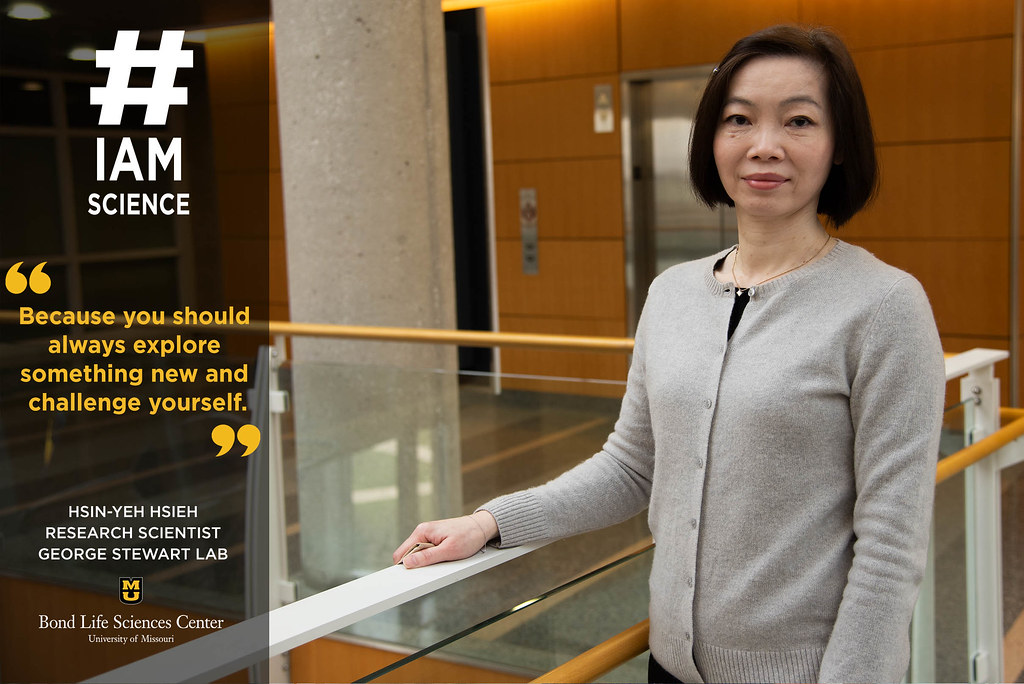By Becca Wolf | Bond LSC
Some scientists go into research for basic science, such as finding an enzyme and figuring out its functions and properties. Others like Hsin-Yeh Hsieh, gravitate toward applied sciences where they use what they know to develop technology.
“Because I can use everything I learned in science as building blocks to create a technology that actually can do something and make impacts in real life, that’s what I like about science,” said Hsieh, a research scientist in the George Stewart lab at Bond LSC.
Hsieh began her science journey in Taiwan, where she went to school for several years, studying molecular and microbiology as well as medical technology. Her love of science began in high school, she explained, “I was very curious about what happens in human health.”
After completing her Bachelor of Science at Kaohsiung Medical University in Taiwan, Hsieh worked in the Cancer Research group of Institute of Biomedical Sciences in Acdemia Sinica in Taiwan, before she came to the U.S. for her graduate study in the Pathology and Anatomical Department of MU Medical School. For her Ph.D. study, she had the opportunity to work on a research in blood banking and transfusion, which focused on enzymatically converting type A and type B blood into universal blood type O. This is where she really found her niche, “I am in the field I enjoy,” she said. However, her biggest challenge for the blood type conversion is how to remove the enzyme from the converted red blood cells before transfusion.
After her doctorate, Hsieh joined David Setzer’s lab in Biological Sciences of MU and later, George Stewart offered her a postdoctoral position in his Molecular microbiology lab.
Collaborating with a multidisciplinary team on MU campus including faculty in Veterinary Pathobiology and in the School of Natural Resources, and students in biochemistry and in bioengineering, Hsieh’s team came up with a design for a cartridge that can immobilize enzyme for blood type conversion, and filter enzyme out of the converted red blood cells (RBCs).
“Let’s say, after the blood goes through this cartridge, it gets converted. The converted RBCs flow through the cartridge, but the enzyme is locked behind so it won’t go along with the product,” she explained.
Hsieh and her team actually filed a patent on this process in December 2019 and are currently seeking more funding to continue testing the process in other industrial applications, such as biofuel and special chemical production.
“I can see its potential,” Hsieh said. “We think it can work in biofuel and it can work in pollutant degradation, but we need to prove it with scientific evidence.”
Said Hsieh, “The technology could turn cellulose to sugar, into glucose, that becomes an energy source,”
It can be expanded beyond these applications as well, with potential to help clean the environment.
She explains, “We actually can break down the herbicide pollutants, like atrazine, in the environment using this enzymatic process.”
It took four years to create this cartridge, overcoming several challenges along the way. That did not intimidate Hsieh.
“I like to see if my idea is right on the track or way off, so that’s quite challenging but also fun,” said Hsieh with a chuckle. “You should always explore something new and challenge yourself.”
Day to day, Hsieh is busy working with undergrads in the lab. Their willingness to learn and try anything intrigues Hsieh’s curiosity and expands her horizons in research.
“The students are so open minded. I say, ‘well, let’s take a new approach and do it,’ and they just go ahead and do it. If we get a good result that proves the concept, that’s great. If not, we learn how to troubleshoot and make it work. In the process, students are trained for critical thinking and research strategy” Hsieh explained. “I think that’s a win-win situation, for them to advance in the career path and also for me to move the project forward.”
Expanding her horizons is important not only in the lab, but as well as in her community. When talking about the friends she has made here in Columbia, Hsieh says, “I met most of my friends while playing tennis, and at a point in time, I counted there were people from 46 countries among us because students come to this campus from all over the world.”
Creating a community with different cultures keeps the life interesting and helps her learn of the world, while staying in Columbia all these years. With unfinished tasks in hands, Hsieh is not planning on leaving anytime soon. Describing Columbia, she “enjoys the atmosphere.”


